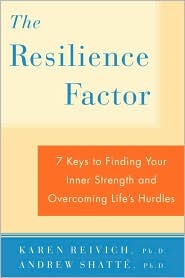.jpg) Perhaps because New York City is the financial capital of the world, anxiety about the economy is everywhere. In Starbucks people sit grimly reading the Wall Street Journal and every lurching move of the Dow causes a collective panic or sigh of relief. . . In this environment how can positive psychology help?
Perhaps because New York City is the financial capital of the world, anxiety about the economy is everywhere. In Starbucks people sit grimly reading the Wall Street Journal and every lurching move of the Dow causes a collective panic or sigh of relief. . . In this environment how can positive psychology help?
In their book The Resilience Factor: 7 Keys to Finding Your Inner Strength and Overcoming Life’s Hurdles (Paperback) Karen Reivich, Ph.D. and Andrew Schatte, Ph.D. make the case that resilience is a key ingredient of happiness and an essential means to adapt and triumph over life’s adversities. A specific skill they discuss called “Putting it in Perspective” is a perfect tool for these times. It is designed to address beliefs about the implications of an adversity and guide individuals to a more accurate way of thinking about it. It works by exposing the chain of catastrophic thinking that
 cascades out of the adversity, replacing it with a more realistic set of beliefs. After identifying the adversity – in this case, the precipitous decline of the stock market – spend a few minutes writing all your worst case beliefs about the events that will occur as a result, in a step-by-step chain. In this example the chain may begin with a belief that “I’ll lose money” and it may end with “I’ll be living under a bridge.”
cascades out of the adversity, replacing it with a more realistic set of beliefs. After identifying the adversity – in this case, the precipitous decline of the stock market – spend a few minutes writing all your worst case beliefs about the events that will occur as a result, in a step-by-step chain. In this example the chain may begin with a belief that “I’ll lose money” and it may end with “I’ll be living under a bridge.”
The next step is to estimate the probability of these fears. Repeat the same process for a separate list of best case beliefs. It may begin with a thought that the market will stabilize and end with you finding a lottery ticket on the street that makes you an instant millionaire. Rate the probabilities of each step in this chain and then spend a few minutes composing a list of most likely outcomes. By using this list it will be easier to zero in on the problem and begin to create solutions. “Putting it in Perspective” can help quell anxiety by changing catastrophic beliefs about the future.

Positive psychology research has shown the powerful connection between physical well-being and emotional well-being. In his book Spark: The Revolutionary New Science of Exercise and the Brain (Hardcover), John J. Ratey, M.D. examines the mind-body connection referencing research that show physical exercise is as effective in altering mood as antidepressants. Getting moving can help create a calm, focused mind in anxious times. So, get to the gym for an aerobic workout and you are likely to feel much better — as long as you are not watching CNBC!
Another proven tool to increase well-being is mindfulness, which has been described as a gift of the present—the here and now. Ellen Langer, Professor in the Department of Psychology at Harvard University states that by increasing mindfulness we escape rigid mindsets and our behavior may be guided rather than governed. Her research shows that increasing mindfulness results in “greater competence, health and longevity, positive affect, creativity, and charisma and reduced burnout to name a few of the findings.” One way of increasing mindfulness is through the practice of meditation where the focus of attention is on a conscious intent to let go of judgments and to open up to a more accepting, patient and trusting experience of the present.
Finally, in times of adversity, positive psychology research shows that the presence of warm and supportive interpersonal relationships is highly correlated to well-being outcomes. Studies suggest that of the many factors that influence happiness, relatedness is at or near the top of the list (Argyle 1987). One of my positive psychology professors summed up this concept in three simple words: Other People Matter.
So, when the market is volatile and the economic news is dire, try tamping down the anxiety level by “Putting it in Perspective,” becoming more physically active, cultivating mindfulness to be present in this moment without ruminating on what may happen in the future and increasing your social interactions. Positive psychology can’t control the direction of the Dow but it just may change the way you think about it.
References:
– Argyle, M. (1987). The psychology of happiness. London: Methuen.
– Langer, E. (2005). Well-being: Mindfulness versus positive evaluation. In C.R. Snyder& S.J.Lopez (Eds.), Handbook of positive psychology (pp.214-230). New York:Oxford University Press.
– Ratey, John J. M.D., (2008). Spark. New York: Little Brown and Company.
– Reivich, K. & Schatte, A. (2003). The resilience factor. New York: Broadway Books.

Gail A. Schneider, J.D., MAPP, brings to positive psychology an extensive background from the world of big business. After a 20 year career at JPMorgan Chase where she was an Executive Vice-President, she now writes about and has developed a workshop on the issues of life transitions and the search for meaning and purpose in mid-life. E-mail Gail here.
This article first appeared in Positive Psychology News Daily




















.jpg)